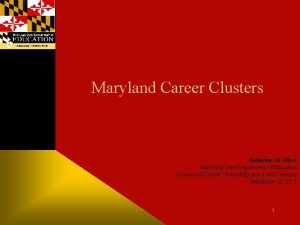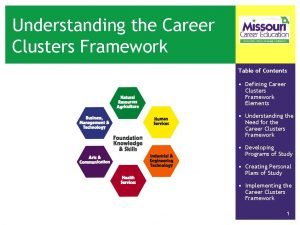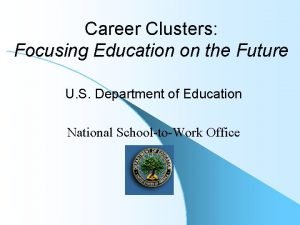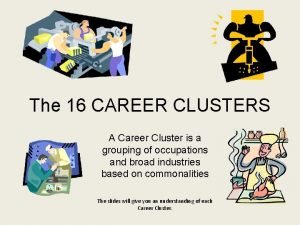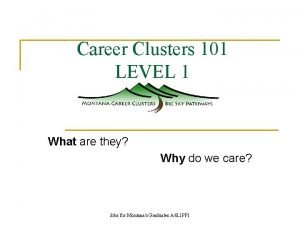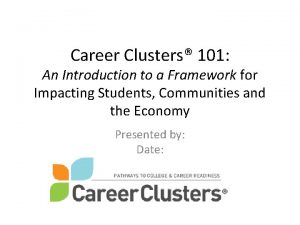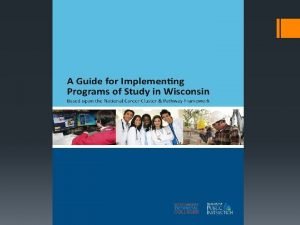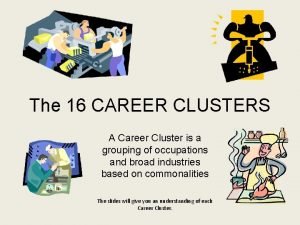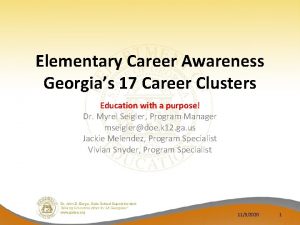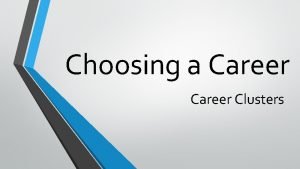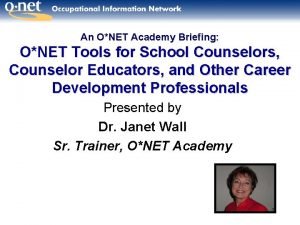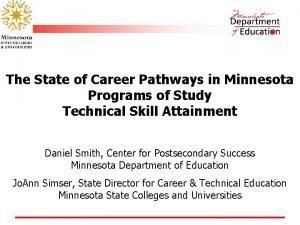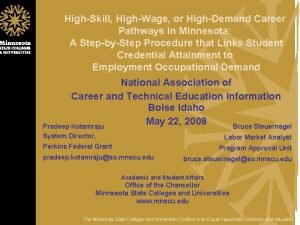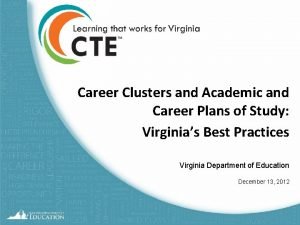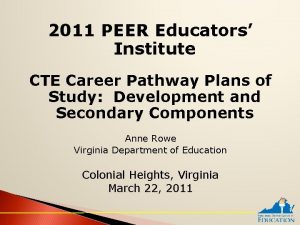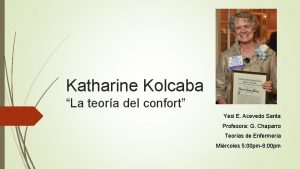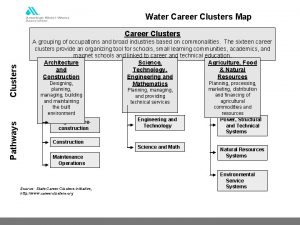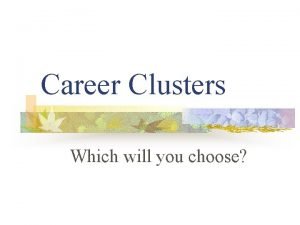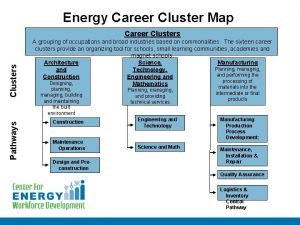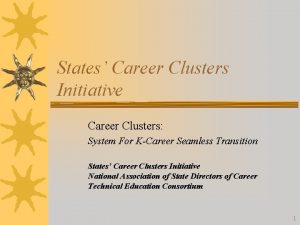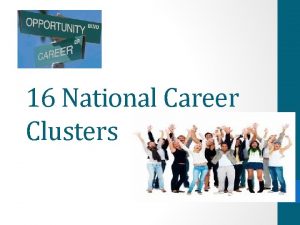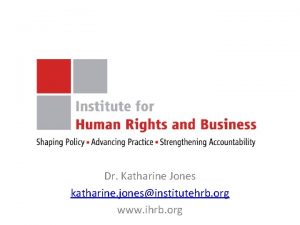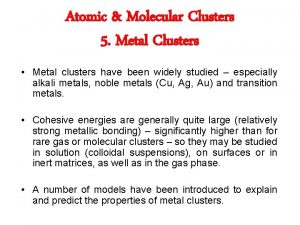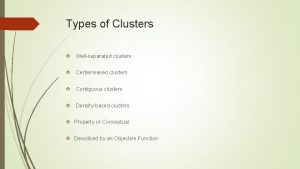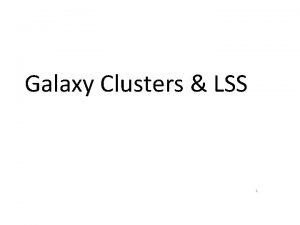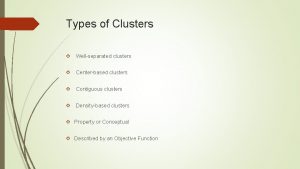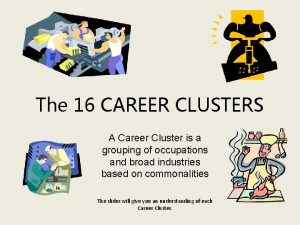Maryland Career Clusters Katharine M Oliver Maryland State


















- Slides: 18

Maryland Career Clusters Katharine M. Oliver Maryland State Department of Education Division of Career Technology and Adult Learning September 23, 2011 1

Presentation Objectives • Provide an overview of Maryland’s Career Cluster Framework • Discuss Career Cluster Implementation and sustainability • Encourage you to consider how the CC’s might advance your work 2

Definition • Career Clusters are groupings of interrelated occupations that represent the full range of career opportunities in Maryland’s economy • Embraced nationally at both secondary and postsecondary levels 3

Ten Career Clusters 1. 2. 3. 4. 5. Arts, Media, & Communication Business, Management & Finance Consumer Services, Hospitality, & Tourism Construction & Development Environmental, Agricultural, & Natural Resources Systems 6. Health & Biosciences 7. Human Resource Services 8. Information Technology 9. Manufacturing, Engineering & Technology 10. Transportation Technologies 4

Career Cluster “Red Book” 5

Career Cluster Organization • • Developed by over 350 MD employers Industry Insights – “teaser” Cluster Knowledge and Skills Career Pathways – Core Business Functions/economic activities of the Industry • Cross Cluster Skill Areas 6

Why Career Clusters? to connect educators and employers • Changing Economy – Global Economy- Value, Speed Agility – Career Progression/Preparation – Shift in Work Organization and Employment • Changing Educational Landscape ØCollege and Career Ready ØAlignment of the Learning levels ØCompletion Agenda 7

Why Career Clusters? – Students struggle to find relevance that coursework will have on their future – CC’s promote success by relating educational experiences to future goals and aspirations – Leads to focused programs of study 8

A Single, Organizing System to: • Create a common language • Bridge education and workforce preparation • Implement priorities for economic development • Improve school and student performance 9

Goals and Outcomes • • Increased academic achievement Increased high school graduation rates Decreased school dropout rates Increased postsecondary transition and completion rates • Increased career success rates – employment/earnings • Better labor market responsiveness 10

Manufacturing, Engineering and Technology 11

Manufacturing, Engineering and Technology Overlapping Features Arts, Media, and Communication Transportation Technologies Business Management and Finance Information Technology Consumer Services, Hospitality, and Tourism Construction and Development Health and Biosciences 12 Environmental, Agricultural, and Natural Resource Systems

Maryland’s System of Career Clusters is used to: • Revise or develop CTE state programs of study • Organize comprehensive high schools into academies, signatures • Inform career development 13

CTE Programs of Study • Grades 9 -16 Program Articulation • High School-College Preparatory Curriculum- Academic Core • A minimum of 4 credits- Career Pathway Core • Work-based Learning Opportunities • Early college credit/industry certifications and licensure 14

CTE Programs of Study • • Program Advisory Committees (LACs) Aligned with postsecondary Early college credit Industry certifications 15

A Model: Project Lead The Way Pre-Engineering Sequence Foundation Courses • Principles of Engineering • Introduction to Engineering Design • Digital Electronics Pathway Courses (HS offers 1 or more) • • Computer Integrated Manufacturing Civil Engineering/Architecture Bio Engineering (In Development) Aerospace Engineering (In Development) Capstone Course/Articulation • Engineering Design and Development 16

Career Pathways • • Core Functions of each industry cluster Become roadmaps for learning Not every pathway has a program of study Secondary CTE chose only what was appropriate for high school level study. • An organizer that allows us to engage employers in our work to meet their needs 17

Career Development • • K-P/Adult Framework Standards by Grade Spans 1. 2. 3. 4. 5. 6. • Self Awareness Career Exploration Career Preparation Job Seeking/Advancement Career Satisfaction/Refocus/Transition Decision-Making Process throughout 18
 Maryland career clusters
Maryland career clusters 16 national career clusters
16 national career clusters Career clusters framework
Career clusters framework Career clusters definition
Career clusters definition What career cluster is a chef in
What career cluster is a chef in Career cluster worksheet
Career cluster worksheet Career clusters framework
Career clusters framework Mcis career cluster inventory
Mcis career cluster inventory Why are career clusters important?
Why are career clusters important? 16 career clusters images
16 career clusters images Georgia career clusters
Georgia career clusters Iseek career cluster interest survey
Iseek career cluster interest survey O*net work importance profiler
O*net work importance profiler Mn career clusters
Mn career clusters Mn career clusters
Mn career clusters Virginia career clusters
Virginia career clusters Vdoe career clusters
Vdoe career clusters Katharine kolcaba theory
Katharine kolcaba theory Como aplicar la teoría del confort
Como aplicar la teoría del confort
